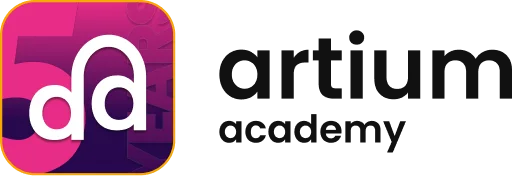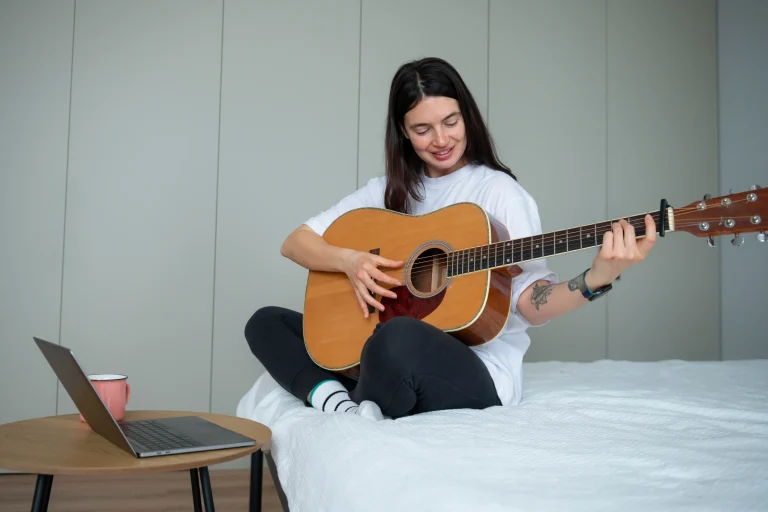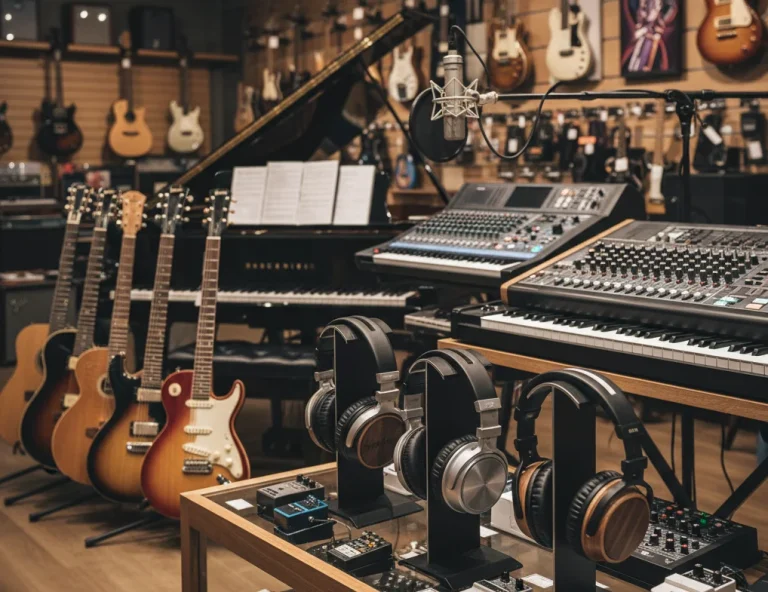All Topics
- Alchemizing Music Concepts for Students
- Artist Spotlight
- artium gift card
- Artium Maestros
- Artium News
- buying guide
- Carnatic Music
- Devotional Music
- Editorials by Ananth Vaidyanathan
- Film Music
- Guitar
- Hindustani Classical Music
- Indian Classical Music
- Indian Folk Music
- Insights
- Instruments
- Karaoke Singing
- Keyboard
- Kids Music
- maestros
- Music Education
- Music for Kids
- Music Industry
- Music Instruments
- Music Legends
- Music Theory
- Music Therapy
- Piano
- piano guide
- Success Stories
- Tamil Film Music
- Telugu Film Music
- Time Theory
- Tools
- Uncategorized
- Vocal Singing
- Vocals
- western classical music
- western music
- Western vocal music
How to Read Guitar Tabs for Beginners?
How to Read Guitar Tabs for Beginners?

Table of Contents
If you’re new to playing the guitar, one of the first things you will encounter is guitar tabs. They are a seemingly popular method of writing down music for guitarists, especially beginners as they simplify the process of learning songs. However, what exactly are easy guitar tabs and how do you read them? Fret not. Whether you’re just starting out or looking to refresh your skills, the guide below will break everything down for you.
If you’re really excited to learn guitar, start with a free trial lesson today!
What Are Guitar Tabs?
Guitar tab, or tablature, is a type of musical notation that is used specifically for fretted string instruments such as the guitar. Unlike traditional sheet music, which uses notes to represent pitch and rhythm, easy guitar tabs represent the strings and frets of your instrument. This makes it easy to understand where your fingers need to be placed on the fretboard.
In a tab, each string on the guitar is represented by a line, and the numbers on those lines indicate which fret to press down on. It is essentially a visual and straightforward way to learn songs without needing to understand standard music notation. Whether you’re learning to play your favourite song at an online guitar course or creating your riffs, tabs are a helpful tool for guitarists at all skill levels.
Understanding the Layout of Guitar Tabs
Let’s review a simple example of an easy guitar tab:
e|—0—1—3—|
B|—1—0—1—|
G|—0—0—2—|
D|—2—3—0—|
A|—3—0—2—|
E|—0—3—0—|
Each line represents one of the guitar strings. These strings are listed from the bottom to the top as follows:
– E (thickest string, closest to your face)
– A
– D
– G
– B
– e (thinnest string, farthest from your face)
This set-up reflects the standard tuning of the guitar (EADGBE) along with the lowest string (E) being at the bottom of the guitar tab and the highest string (e) at the top. The numbers on these lines indicate which fret to press down.
For instance:
– A “0” means you play the string open (without pressing any fret).
– A “1” means you press down on the 1st fret.
– A “3” means you press down on the 3rd fret.
When you notice a number on a line, you simply place your finger on that particular fret of the corresponding string and play it.
Guitar Tabs: How to Read Frets and Numbers
The most essential part of reading basic guitar chords for beginners is understanding how to read the fret numbers. These numbers tell you exactly which fret to press down on a specific string.
Let us dissect this step by step the way it is done in online guitar classes:
- Open Strings (0) – When you see an “0” on a string, it means that the string should be played open–no fingers pressing any frets.
- Frets (1,2,3, etc.) – The numbers that follow the lines represent the specific fret on the corresponding string. For instance, if you see a “3” on the low E string (E|—3—), you should press down on the 3rd fret of that string.
- Multiple Numbers – At times, these easy guitar tabs will show multiple numbers on a string in a row, indicating that you need to play those frets sequentially. For example, if you see a “3, 5, 7” on the D string, you press the 3rd fret, then the 5th fret, and then the 7th fret, one after another.
- Strings in sequence – These lines often show numbers in a sequence format, which means that you can play multiple strings simultaneously (usually for guitar chords for beginners).
Symbols and Techniques in Guitar Tabs
Guitar tabs aren’t limited to include just numbers. They also include special symbols to indicate different techniques and guitar effects. Here are some of the most common symbols you’ll encounter when enrolling in online guitar classes:
- Hammer-ons (h) – A hammer-on is when you pick a note and then use your fretting hand to press a higher fret without plucking the string again. For example, a “5h7” means play the 5th fret and then ‘hammer on’ to the 7th fret.
- Pull-offs (p) – A pull-off is the opposite of a hammer-on. You pluck a note and then pull your finger off to let the lower note ring out. Such as “7p5” means play the 7th fret and then pull off to the 5th fret.
- Bends (b) – Bending a note means pushing the string up or down to raise its pitch. You’ll often see bends indicated with a ‘b’ symbol. Now to demonstrate, “7b9” means that you should bend the note at the 7th fret to reach the pitch of the 9th fret.
- Slides (/ or ()) – A slide is when you play one note and then slide your finger to a different great. A forward slash (/) indicates a slide up (higher pitch) and a backlash () indicates a slide down (lower pitch). For example, “5/7” means to slide from the 5th fret to the 7th fret.
- Vibrato (~) – The vibrato is a technique when learning about easy guitar tabs where you move your finger back and forth quickly to create a wobbly, trembling effect. It is indicated by the tilde (~) after the note.
- Palm muting (pm) – Palm muting is a technique where you rest the edge of your palm lightly on the strings near the bridge while plucking them. It is often notated as “PM” with a line above or below the notes that should be muted.
Reading Simple Chords in Guitar Tabs
One of the most useful things to learn in easy guitar tabs is how to read and play chords. Chords are just multiple notes played together, and tabs make it easy to see where to place your fingers.
Here is an example of basic guitar chords for beginners:
e|—0—|
B|—1—|
G|—0—|
D|—2—|
A|—3—|
E|—x—|
This is a C major chord. The “x” on the low E string means that the string is not played (avoid strumming it). Whereas, the numbers on the other strings tell you which frets to press down. You could play these guitar chords for beginners by pressing the 3rd fret of the A string, the 2nd fret of the D string, the 1st fret of the B string, and letting other strings ring open.
As you get more comfortable reading easy guitar tabs, you’ll come across more complex chord shapes and progressions. But fret not–begin slowly and focus on getting the chords right.
Tips for Improving Tab Reading Skills
Here are certain tips and tricks for improving your tab reading skills that will be taught in your online guitar course:
- Practice using simple songs – Begin with simple and slow songs that use basic chords. This will help you get a hang of readingguitar tabs, while also building muscle memory for your fingers.
- Play along with the tab – Find a recording of the song you’re learning and try to play along. This will help you get used to the rhythm and timing of the piece.
- Look for patterns – Many songs use common chord progressions or repeated riffs. Once you recognise these patterns, it will become easier to anticipate what comes next.
- Use online resources – There are tons of websites and apps that offer an online guitar course. Websites such as YouTube have tabs for practically every song under the sun. Use these alternatives to practise your reading.
- Learn to count beats – While tabs show you where to place your fingers, they do not tell you how long to hold the notes. To improve your timing, practice counting the beats in each measure. For more advanced pieces, you might want to pair your easy guitar tabs with traditional sheet music to improvise on your rhythm.
Conclusion
Reading guitar tabs is one of the easiest and quickest ways to start playing your favourite songs on the guitar. It allows you to visually interpret music and provides you with a clear roadmap of what to do with your fingers. While it may take some time to master the various symbols and techniques used in easy guitar tabs, the key is consistent practice.
For classes teaching basic guitar chords for beginners, stay patient and continue to build your foundation skills. Whether you’re strumming simple chords or tackling more intricate solos, keep practising and you’ll improve in no time. If you want structured, personalised, expert guidance with a step-by-step approach to learning the guitar, then we, at Artium Academy offer 1:1 guitar music lessons that can help you master the basics and beyond.
Book A FREE Trial with us to know more about guitar tabs!






